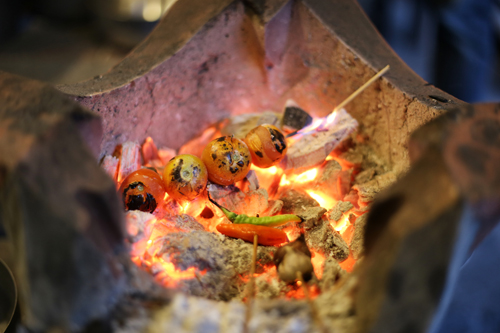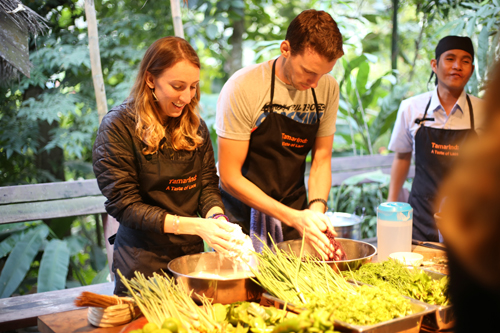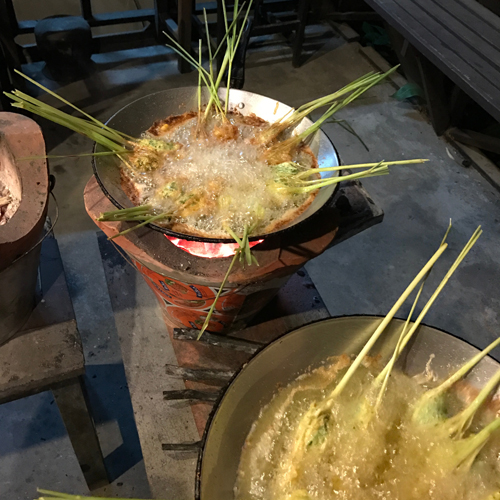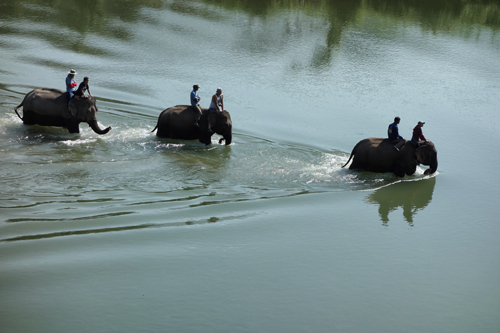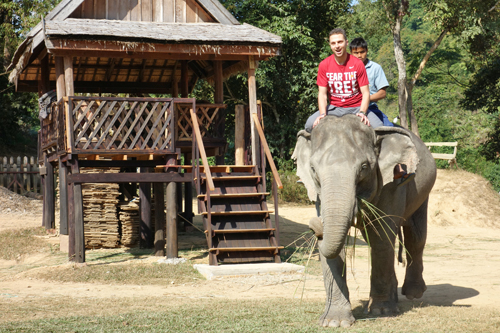The New Year is the only holiday of the year for the Hmong. It is, as you can imagine, a big to-do. It’s a chance to feast with family. It’s a chance to show off their new clothing for the year. And it’s time for young Hmong to meet a partner at the market. (Thankfully the practice of kidnap and rape as it once was has largely been abandoned, but there is confusion on the idea of consent.)
Sam, our Black Hmong guide in Sapa, had spent the entire trek talking about and preparing for New Years. We never imagined we’d be invited to celebrate with the White Hmong we’d met in the class in Luang Prabang.
There were four Hmong boys in total, each eager to share their village. They picked us up on motorbikes – sans helmets –and drove us the thirty minutes to the first village of the night.
We went in thinking we knew what to expect, but these houses were smaller and families bigger. There was no loft, and there was no indoor plumbing. The views were of the house next hour, a stones throw away. The kitchens were mostly outside, since there wasn’t room for a fire pit indoors. The homes were made of a mix of materials, some concrete, some brick, some with tin sides, all with dirt floors. There were usually at least three people to a bed, with sheets hung for some separation. Each house had an altar in it, made new every year. The altar gave you a hint into the financial stability of the family. Some were just a piece of white paper with a design drawn in chicken blood and cut shapes representing the number of people in the household. There were no bathrooms. People bathed in the river and boiled buckets of water for cooking. Kids ran with old bike tires down the road for fun and helped tend to the fire. They played with chickens as if they were puppies. Here, there were no pigs. Pigs are too expensive to buy and to keep. There were no tables and chairs as we’d seen before, but instead short blocks, one with a tray balanced on top to serve as a table. The cutting boards were big, beautiful blocks of wood and the dishes looked like china. It was New Years, and the children were buzzing with excitement.
The chicken activities were just beginning at the first house when we arrived. A large group huddled in a bunch as the head of household held a chicken by its legs. When he began the blessings, we moved together in a circle making three full laps to ward off bad spirits. As we moved, he swung the chicken above us. The chicken hit its head on each swing, but didn’t make a peep. We then moved in the opposite direction, three laps, inviting good spirits into the household. When it was over, the children placed leaves threaded together into a bracelet into the center of the ring and we dispersed. The chicken was killed and later that night, we came back to enjoy.
At the second house we saw a shaman at work. He was praying, hitting the doorway with two pieces of a water buffalo’s horns while shaking a circle with symbols. He’d throw it down, and where the symbols landed determined his next chant. Next to him was a basket of eggs with incense. Each egg represented a family member who had passed. Shamans were different here than what we learned about in the Black Hmong community. Shamans were men who’d once suffered and overcome an illness, learning the craft in his sickness. There were many shamans – almost one in every extended family – and the meaning of the chants had already been lost. In Hmong the shaman we spoke with replied, “It’s just what you’re supposed to say.”
At the third house we had our first of four dinners. Here, we crouched around a table set up for us inside and ate chicken killed earlier that night with white rice from the latest harvest. The chicken had been cooked with purple cabbage and cut with a knife into pieces leaving unavoidable shards of bone. The broth sat on the table as well, and everyone was given a large spoon for dipping and re-dipping into the bowl. The chicken was gamey and over boiled, and to them it was a treasure. Chicken is something they eat maybe once every three or four months.
We were always the first to be served. The family watched us as we ate, and when we were done would eat whatever remained. At one home, Lindsey tried the chili sauce. It was HOT and even the family laughed from where they sat on the bed watching us eat, understanding the universal face of heat. At each house the boys would joke that we were missing out as they ate the head, the heart, and other assorted chicken parts that frankly, I didn’t know were edible.
This was one of the most remarkable nights of our lives and certainly the highlight of the trip. We’re so grateful to have been invited into the homes of the White Hmong for New Year’s and for the chance to see what truly felt like the other side of the world. The boys told us that their greatest wish in life is to find love and to make a family, and in that, we felt completely at home.
